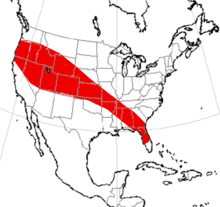Enhydrocyon
| Enhydrocyon Temporal range: Early Oligocene–Early Miocene | |
|---|---|
| Scientific classification | |
| Kingdom: | Animalia |
| Phylum: | Chordata |
| Class: | Mammalia |
| Order: | Carnivora |
| Family: | Canidae |
| Subfamily: | Hesperocyoninae |
| Genus: | †Enhydrocyon Cope, 1879 |
| Type species | |
| †Enhydrocyon stenocephalus | |
| Species | |
| |
 | |
| Range of Enhydrocyon fossil evidence | |
Enhydrocyon is an extinct genus of bone crushing dog which inhabited North America exclusively during the Oligocene living from around 28.7—22.0 Ma (AEO) and existed for approximately 6.7 million years.[1]
Enhydrocyon's dentition suggests this animal was a hypercarnivore or mesocarnivore.[2][3] Species of Enhydrocyon were large, powerfully built carnivores with a short snout and deep jaws reminiscent of a jaguar.[4] David Macdonald describes Enhydrocyon as a Canid-equivalent of a big cat-like carnivore.[5]
Taxonomy
Enhydrocyon was named by Cope (1879). Its type is Enhydrocyon stenocephalus. It was assigned to Canidae by Cope (1879) and Munthe (1998).[6]
Morphology
Two specimens were examined by Legendre and Roth for body mass. The first specimen was estimated to weigh 22.1 kg (49 lb). The second specimen was estimated to weigh 22.4 kg (49 lb).[7]
Species
- †Enhydrocyon basilatus (23.5—22.7 Ma AEO). One specimen found at the Manville site, Niobrara County, Wyoming. One specimen weighed 70 lbs.[8]
- †Enhydrocyon crassidens (24.4—22.7 Ma AEO). Type locality: Monroe Creek (American Museum of Natural History, Rosebud 12), Oglala Lakota County, South Dakota. Weight estimated to be 45-50 lbs. (Legendre & Roth).
- †Enhydrocyon pahinsintewakpa (~24.5—23.3 Ma AEO). Type locality: Sharps SDSM V-5361 aka LACM 1983 (Sharps Formation), Oglala Lakota County, South Dakota. Weight was approximately 40-45 lbs. (John Alroy), (Legendre & Roth, S. Legendre and C. Roth. 1988. [9]
- †Enhydrocyon sectorius (nomen vanum)
- †Enhydrocyon stenocephalus (25.9—25.7 Ma (AEO). John Day Units G, H, I, and J., Wheeler County, Oregon. Weight 45-50 lbs. (Legendre & Roth).
References
- ↑ http://paleobackup.nceas.ucsb.edu:8110/cgi-bin/bridge.pl?action=checkTaxonInfo&taxon_no=41211&is_real_user=1 Enhydrocyon: Basic info.
- ↑ R. M. Nowak. 1991. Walker's Mammals of the World. Maryland, Johns Hopkins University Press (edited volume) II
- ↑ Q. Ji, Z.-X. Luo, C.-X. J.R. Yuan Wible, J.-P. Zhang, and J.A. Georgi. 2002. The earliest known eutherian mammal. Nature 416:816-822
- ↑ David Macdonald. The Velvet Claw: A Natural History of the Carnivores. BBC Books: London; 1992. p83.
- ↑ David Macdonald. The Velvet Claw: A Natural History of the Carnivores. BBC Books: London; 1992. p83.
- ↑ R. L. Carroll. 1988. Vertebrate Paleontology and Evolution. W.H. Freeman and Company
- ↑ S. Legendre and C. Roth. 1988. Correlation of carnassial tooth size and body weight in recent carnivores (Mammalia). Historical Biology 1(1):85-98
- ↑ PaleoDB collection 17801, Authorized by John Alroy.
- ↑ Correlation of carnassial tooth size and body weight in recent carnivores (Mammalia). Historical Biology 1(1):85-98, Legendre & Roth
- Wang, X. (1994). "Phylogenetic systematics of the Hesperocyoninae (Carnivora, Canidae)". Bulletin of the American Museum of Natural History. 221: 1–207. hdl:2246/829.
- Xiaoming Wang